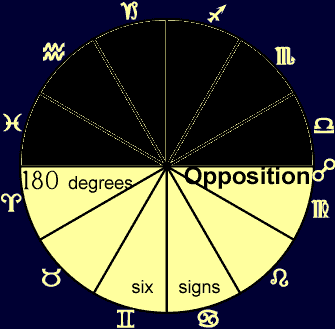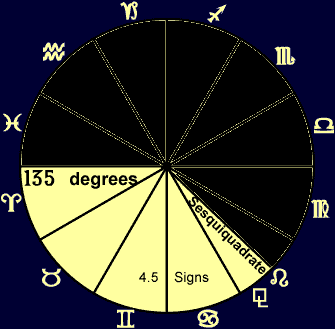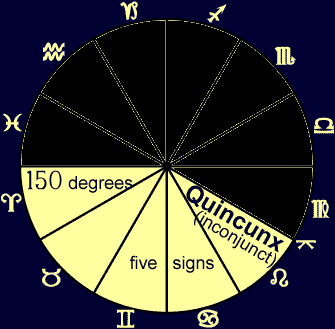|
The energy of any one planet or planets in the position they rent in zodiac houses are also affected by how the planets are positioned with respect to each other at any time. This is the conversation, if you will, that takes place that influences the effect on the person's chart. Some positions produce arrangements that reinforce these positive energies. While others bring about disruptive and difficult effects. The relationship between the planets are called Aspects. They refer to the ANGLE or degree the position describes. The major aspects are: oppositions and squares, or conjunctions, sextile and trines. ~When any two planets are in the same sign of the zodiac, they are in Conjunction. ~If any two planets are opposite each other in the zodiac, then they are in Opposition. ~If any two planets are at 90 degree angles (or right angles) to each other then they are Squared. ~When any two planes are at 60 degree angles to each other, then they are Sextile. ~When they are 120 degrees apart they are Trine. The effect of an aspect between two planets is strongest when the fastest planet reaches the exact angle of the aspect. However effects can be felt over several degrees (called the orb), depending on which planet is involved and on whether it is a major or a minor aspect. The interpretation of aspects is based impart on how the planets fall into signs with similar or conflicting elements and qualities. For example, the square aspect has planets in the same quality or mode, but conflicting elements (e.g., fire and water) while the trine aspect the planets are in the same element, but stimulated by different qualities. The aspects are described as harmonious or inharmonious. Harmonious aspects can help matters along. Inharmonious aspects ("badly" aspected planets) introduce stresses, many of which can actually help you if you learn to deal with them. A brief description of the meaning of the major aspects is as follows: *Note: in determining the aspect an astrologer counts SIGNS between the two planets and NOT houses. This is particularly important when dealing with a chart that has an intercepted house or sign. Neither harmonious or inharmonious, this aspect merges and intensifies the energies of two planets. Inner tension can arise if the planets have conflicting natures.
Harmonious aspect that helps energies flow toward attainment of your goals, provided you make some conscious effort to achieve them yourself.
Inharmonious aspect causing tensions and obstacles for you to overcome. It forces you to choose between your conflicting inner needs and urges.
Harmonious aspect that brings the two energies into an easy interplay. This can create such beneficial consequences that things become to easy for you and you become lazy.
Inharmonious aspect creating inner tensions between your planetary urges. It also creates dynamic tensions with others, which you must reconcile if you want to maintain harmonious relationships.
A minor harmonious aspect. It is considered important to some astrologers in natal astrology. It is similar to sextile but minor, It also can mitigate other inharmonious aspects.
A minor inharmonious aspect. This causes friction and irritation between planets in aspects. This causes mild stress and tension.
A little more minor than Semi-Square. This causes irritation, aggravation and discord.
This aspect is another minor inharmonious one. It suggests a need for adjustment.
ASSIGNMENT:
Looking at your natal chart, (click
here to receive a free natal chart wheel by email) determine
what planets are TRINED each other. Which planet is the faster
of the two. Denote the aspect. As an example if Pluto and Mercury
are trined, Mercury is the faster of the two planets so it would
be written like so: If your natal chart comes with an aspectarian, study ALL your planetary aspects and the wheel chart. Practice counting the signs between planets to verify the aspectarian grid. On to Lesson 5: The Transits Briefly Explained |Introductory
Lesson on Astrology || Lesson
2:The Signs|| Frequently
Asked Questions |Source
Bibliography | Glossary | Birth
Charts |Transit
Charts |Career
Charts | Relationship
Charts | Horary
Charts | ©2001-2005 , Indigo Ray Astrology Inquiry, All Rights Reserved |
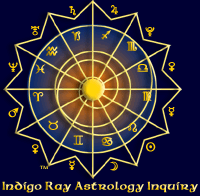
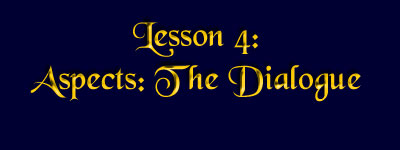
 Conjunction
(0-10 degrees):
Conjunction
(0-10 degrees):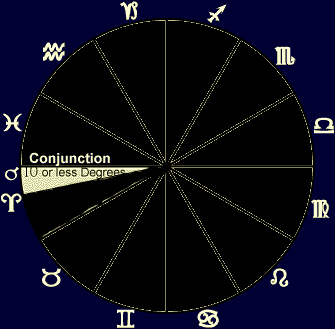
 Sextile
(60 degrees, two signs apart):
Sextile
(60 degrees, two signs apart):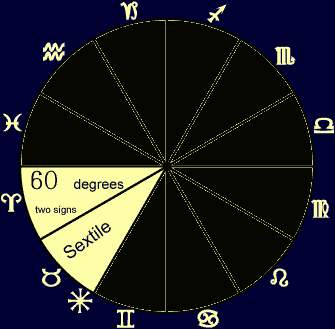
 Square
(90 degrees, three signs apart):
Square
(90 degrees, three signs apart):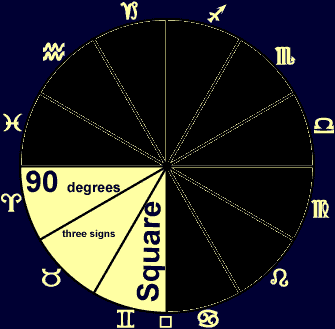
 Trine
(120 degrees, four signs apart):
Trine
(120 degrees, four signs apart):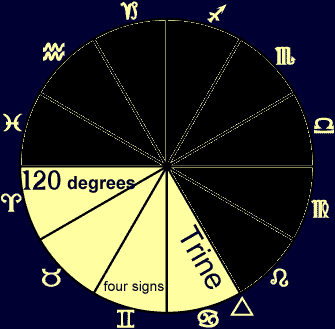
 Opposition
(180 degrees, six signs apart):
Opposition
(180 degrees, six signs apart):